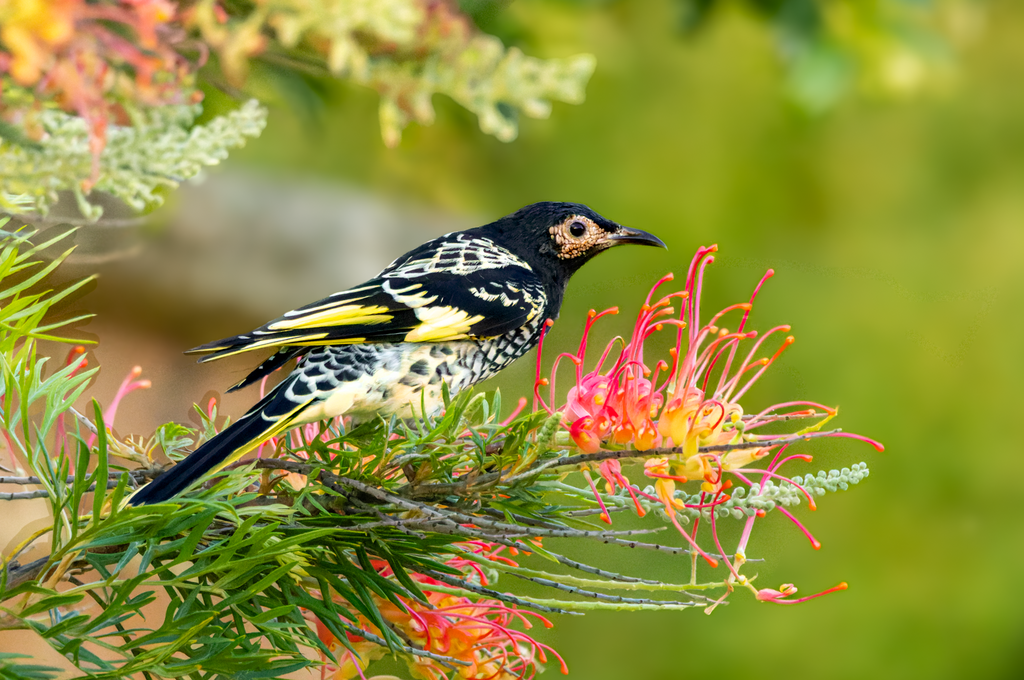Into the great genome: new tracker for Australia’s genomic biodiversity
This press release is republished with permission from CSIRO. Read the original here.
Tracking our progress on genomes across Australian species for research, monitoring, conservation and protection.
A world-first tool is tracking Australia’s progress in sequencing the full genomes – or genetic blueprints – of the country’s 250,000-plus known and catalogued species.
Launched today, Genome Tracker reveals that only two per cent of Australia’s known and catalogued species have had their genome sequenced at least once.
The online dashboard is part of the Australian Reference Genome Atlas (ARGA), a platform delivered through the Atlas of Living Australia, Bioplatforms Australia, Australian BioCommons and the Australian Research Data Commons.
Regent Honeyeater (Anthochaera phrygia). Image credit: Joel Poyitt (CC-BYNC)
CSIRO’s Dr Kathryn Hall, ARGA project lead, said Genome Tracker is a step change in how genomic data coverage can be tracked, assessed and prioritised.
“Whole genome sequencing for plants and animals provides insights for ecology, conservation biology, agriculture and biosecurity,” Dr Hall said.
“It lets us peer back through evolutionary time to understand how species have adapted to the unique landscapes of Australia.
“Genome Tracker clearly shows which parts of the family tree of life have strong representation and which are under-sequenced or entirely missing.
“It helps researchers map existing genomic coverage and highlights under-represented areas for research."
The ultimate goal is to have genomes published for a wide cross-section of Australian biodiversity.
“Genomes help us understand the adaptive traits of species – how they’ve uniquely adapted to their environment and how they’re evolving,” Dr Hall said.
“The higher branches in the taxonomic tree of life represent older genomic divergence.”
Genome Tracker tells us that these ancient branches currently have just 32 per cent genomic coverage. Improving their representation will deepen our understanding of how species have diversified and evolved over time.
“These are exciting times for biology. Genomes give us roadmaps to trace how life came to be as it is today – and how we can work with that knowledge to protect it for generations to come,” Dr Hall said.
“We can look at what drove changes in organisms, and this could help predict how species might adapt in the future.
“As ecosystems change, this data spotlights populations for monitoring, conservation and protection.”
Taxonomic descriptors, species occurrence records, and ecotype layering allow researchers to use ARGA to filter and search the indexed genomics data, and to track every species in Australia.
Genome Tracker and ARGA use existing research infrastructure capabilities of the Atlas of Living Australia (ALA), Australia’s national biodiversity data infrastructure which is hosted by CSIRO, the national science agency.
Fast facts:
Tasmanian Devil (Sarcophilus harrisii): Australia’s first published genome. Released in 2011, it was critical for research into Devil Facial Tumour Disease, conservation, and as a model for cancer resistance studies.
Tammar Wallaby (Notamacropus eugenii): The first kangaroo genome, fully published in 2012 after three years of work. It revealed the genes for encoding special antimicrobial proteins in its milk and around 1,500 smell-related genes.
Regent Honeyeater (Anthochaera phrygia): The first honeyeater genome was published in 2019. It showed only a 9 per cent loss of genetic diversity despite low population numbers, highlighting the need to preserve remaining genetic diversity and prevent inbreeding.
Numbat (Myrmecobius fasciatus): Published in 2022, the genome showed they have reduced bitter and sweet taste receptors, but enhanced umami receptors, as an adaptation to their specialised termite diet.
Orange-bellied Parrot (Neophema chrysogaster): Genome published in 2025, the first for a critically endangered parrot. It will help strengthen captive breeding programs. The first parrot genome was only published in 2024.
Southern Corroboree Frog (Pseudophryne corroboree): Published in 2025, this genome is three times the size of the human genome. The genome will help researchers understand which genes affect resistance or susceptibility to the chytrid disease. Ultimately, the conservation goal is to breed frogs’ resistance to the chytrid fungus for release back into the wild.
The Australian Reference Genome Atlas (ARGA) is enabled by funding from the National Collaborative Research Infrastructure Strategy and delivered by the Atlas of Living Australia (ALA), Bioplatforms Australia, Australian BioCommons and Australian Research Data Commons (ARDC) (https://doi.org/10.47486/DC011).
ARGA and ALA are hosted by CSIRO, Australia’s national science agency, as key Australian biodiversity data infrastructure. ARGA integrates data sourced from a number of international repositories, including NCBI GenBank, EMBL-ENA and Bioplatforms Australia.

